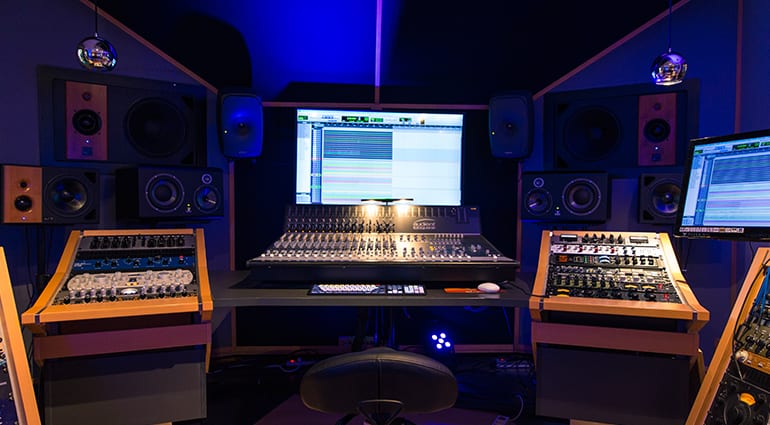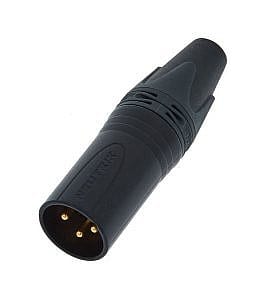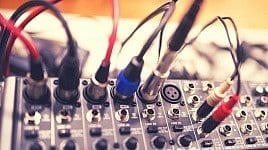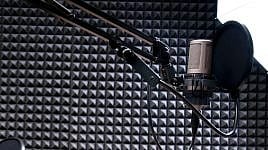
The cabling in the home studio is one of those things that you first worry about when there is danger to your body and soul: when you stumble over cable loops, or instead of music only hum comes out of the speakers.
Here are a few tips for anyone planning to rewire or optimise the existing wiring of their home studio.
Tip 1: If possible, balanced!
 In principle, two types of signal transmission are used in audio technology: balanced and unbalanced transmission. Unbalanced cables have a conductor sleeve and a tip. It can be recognised by the connectors with two contacts (only one plastic separator), for example the instrument cable or cinch cable.
In principle, two types of signal transmission are used in audio technology: balanced and unbalanced transmission. Unbalanced cables have a conductor sleeve and a tip. It can be recognised by the connectors with two contacts (only one plastic separator), for example the instrument cable or cinch cable.
 The classic balanced cable is the microphone cable, it has two conductor sleeves and a tip (two plastic separators). Accordingly, the plugs of a balanced cable – usually XLR plugs – have three pins. Balanced transmission is an “ungrounded” transmission; only the two conductor sleeves of the cables are involved in the transmission. For unbalanced transmission, the cable screen is used as the conductor for the audio signal because, after all, we need a closed circuit.
The classic balanced cable is the microphone cable, it has two conductor sleeves and a tip (two plastic separators). Accordingly, the plugs of a balanced cable – usually XLR plugs – have three pins. Balanced transmission is an “ungrounded” transmission; only the two conductor sleeves of the cables are involved in the transmission. For unbalanced transmission, the cable screen is used as the conductor for the audio signal because, after all, we need a closed circuit.
Balanced transmission with stereo jacks is also possible. In the home studio these are often used because the (balanced) outputs of an audio interface are often designed as jack sockets to save space. What’s important for a balanced cable are the number of contacts, not the type of connector.
Whether your outputs and inputs supply balanced signals is indicated by an appropriate imprint on the device. The English expressions “balanced” and “unbalanced” are often used here. If there’s nothing there, you have to check the technical specifications.
Only balanced cable routing offers effective protection against electromagnetic interference (noise/buzz/hum): The signals on the two cores are transmitted with their phase shifted and the difference formed at the end of the balanced transmission eliminates interference. This works pretty well, so you should connect all outputs and inputs in your home studio that can supply or receive balanced signals accordingly!
You can connect balanced and unbalanced inputs and outputs, but you will lose -6 dB of level. And you lose the special protection against interferences! Unbalanced connections are much more susceptible to noise. Every guitarist knows the problem of single coil pickups on a Fender Stratocaster. Unbalanced connections should always be kept as short as possible in the home studio.
Here are two typical examples of unbalanced cables, a 3 m jack cable (the sssnake IPP1030) and an adapter cable from RCA to jack (Cordial CFU 3 PC):
Balanced cables, on the other hand, include a 10 m microphone cable such as the pro snake TPM 10 or the CFM 1.5 W stereo jack cable from Cordial:
Tip 2: Quad cables for critical applications
![]() The noiseless effect of a balanced connection can be further improved by using a microphone cable with four inner conductors, a so-called quad cable, for example the Sommer “Square”. It consists of two twisted pairs of wires. If these wires are soldered in such a way that a plug contact is connected to one wire from each of the pairs (one says “soldered crosswise”), the elimination of interferences increases by up to 20 dB due to the phase rotation of the balanced cable routing. However, quad cables are more expensive than normal microphone cables because they require twice the amount of material. But if you generally have problems with interference, such cables can be the solution.
The noiseless effect of a balanced connection can be further improved by using a microphone cable with four inner conductors, a so-called quad cable, for example the Sommer “Square”. It consists of two twisted pairs of wires. If these wires are soldered in such a way that a plug contact is connected to one wire from each of the pairs (one says “soldered crosswise”), the elimination of interferences increases by up to 20 dB due to the phase rotation of the balanced cable routing. However, quad cables are more expensive than normal microphone cables because they require twice the amount of material. But if you generally have problems with interference, such cables can be the solution.
Tip 3: Coaxial cables for S/PDIF cabling
The most common interface for digital signals in the home studio is the S/PDIF interface. The developers chose the cinch plug for the transmission because it was cheap and available everywhere. As a result, many digital S/PDIF signals are still transmitted via cheap HiFi RCA cables today. And it is successful because the distances are usually very short.
However, there are special cables for the high transmission frequencies of the digital signals: the coaxial cables. If you need S/PDIF cables longer than about three meters, you should get away from the audio cinch cable and use the special coaxial cable. For optical transmission of the S/PDIF signal via the Toslink cable, a safety limit of five meters has been set. In practice, more is usually possible if the cable is not too bent. Personally, however, I hardly use optical cables, simply because it is very difficult to assemble them myself, and soldering the cables for the home studio yourself is something that requires expertise!
1. Cordial CPDS1 CC S/PDIF Interface cable / 2. the sssnake Optical Cable 2m
Tip 4: Do not lay signal cable and power cable in parallel
Electromagnetic interferences are caused by magnetic fields. And these, in turn, are created wherever electricity flows. It’s no surprise: a lot of electricity flows through the power cable! If there is a live cable next to an audio cable, the magnetic field induces interference voltages in the audio cable. The result: noise.
Only balanced cables are effective against these interferences, but only to a certain extent. For this reason, you should lay signal lines and power lines as far away from each other as possible. In the rack it is advisable to reserve the side with the power supply sockets of the devices as the power side and to lead out all signal lines on the other side of the rack – even if this extends some cable length! Avoid longer distances of parallel power and signal cables at all costs!
Tip 5: Cable order is sound advice
Proper cabling in the home studio is not just a visual matter, it is also responsible for clean sound. But to keep track of the many cables that accumulate behind a rack or under your desk over time, mark or label the cables. The simplest method is with coloured adhesive tape, in the best case with paper labels, which you fix with transparent shrink tube. For many connectors there are also coloured Coding Rings, for example for the Neutrik connectors. However, you can only make such markings if you solder the cables yourself, it’s not possible to add them afterwards.
- Neutrik XXR Yellow
- Neutrik XXR Green
Tip 6: Do it yourself!
Do it yourself (DIY) is actually unavoidable for studio cabling. There are many reasons why it is strongly advised to solder your studio wiring yourself. The greatest is quite banal: It’s much cheaper. In addition, the length of purchased cables rarely fits perfectly. Either it is too taut or you have spirals of cables lying around, which you end up somewhere under the rack collecting dust. Rewinding loose cables is not a good idea, as it enhances the antenna effect. Then there are unbalanced cables and you risk getting Uzbekistan radio signals into your studio. You can find Cable Per Meter at this link.
Tip 7: Keep it simple!
The important thing is: Don’t worry too much. Even the professionals say that cables boggle their minds from time to time. This is because equipment is constantly being added or dismissed. Cabling is a constantly morphing creature so plastic cable ties from the DIY store are not a good idea. Instead consider buying fabric cable ties with velcro, which you can open easily without tools.
Admittedly, with these short lines I only scratch the surface. You could write a book about cables and the cabling of recording studios…
If you are interested, you can continue reading about this topic:
Related Links
Click here for all the cables on thomann.de
One comment
Leave a Reply
You are currently viewing a placeholder content from Facebook. To access the actual content, click the button below. Please note that doing so will share data with third-party providers.
More InformationYou are currently viewing a placeholder content from Instagram. To access the actual content, click the button below. Please note that doing so will share data with third-party providers.
More InformationYou are currently viewing a placeholder content from X. To access the actual content, click the button below. Please note that doing so will share data with third-party providers.
More Information










Stan says:
Hi, so I live in Ghana and am starting my first home studio but am not sure what length of xLR cable to buy for my microphone. Any general rules on cable length?